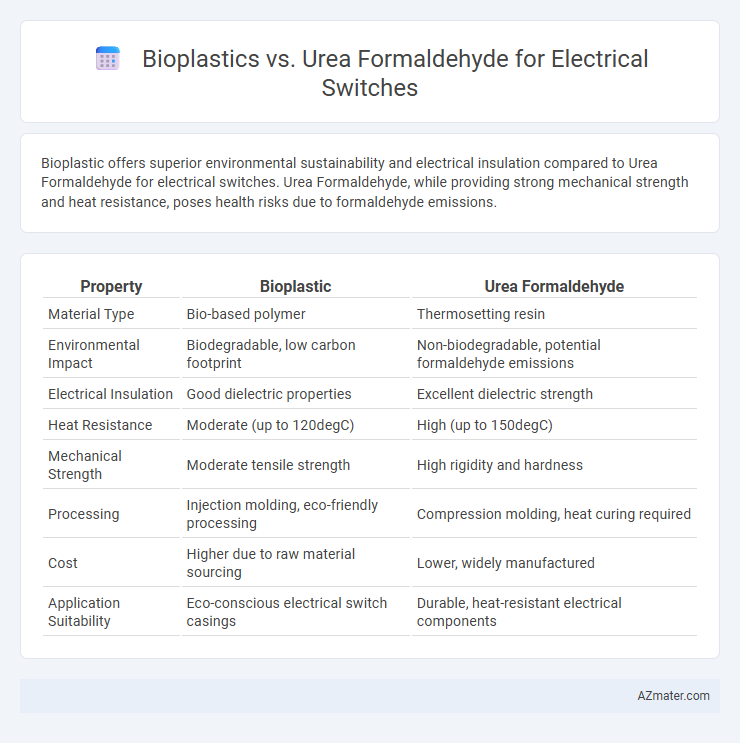Bioplastic offers superior environmental sustainability and electrical insulation compared to Urea Formaldehyde for electrical switches. Urea Formaldehyde, while providing strong mechanical strength and heat resistance, poses health risks due to formaldehyde emissions.
Table of Comparison
| Property | Bioplastic | Urea Formaldehyde |
|---|---|---|
| Material Type | Bio-based polymer | Thermosetting resin |
| Environmental Impact | Biodegradable, low carbon footprint | Non-biodegradable, potential formaldehyde emissions |
| Electrical Insulation | Good dielectric properties | Excellent dielectric strength |
| Heat Resistance | Moderate (up to 120degC) | High (up to 150degC) |
| Mechanical Strength | Moderate tensile strength | High rigidity and hardness |
| Processing | Injection molding, eco-friendly processing | Compression molding, heat curing required |
| Cost | Higher due to raw material sourcing | Lower, widely manufactured |
| Application Suitability | Eco-conscious electrical switch casings | Durable, heat-resistant electrical components |
Introduction to Bioplastic and Urea Formaldehyde
Bioplastic, derived from renewable biomass sources such as corn starch or sugarcane, offers an eco-friendly alternative to traditional plastics with biodegradability and reduced carbon footprint. Urea formaldehyde, a thermosetting resin made from urea and formaldehyde, is widely used in electrical switches due to its excellent insulating properties, high hardness, and resistance to heat and chemicals. Comparing Bioplastic and Urea Formaldehyde involves evaluating environmental impact, electrical insulation efficiency, and mechanical durability in switch applications.
Material Composition and Properties
Bioplastic for electrical switches is primarily composed of renewable polymers such as polylactic acid (PLA) or polyhydroxyalkanoates (PHA), offering biodegradability and lower environmental impact. Urea formaldehyde, a thermosetting resin made from urea and formaldehyde, provides high mechanical strength, excellent electrical insulating properties, and heat resistance, crucial for switch safety and durability. While bioplastics excel in sustainability and reduced toxicity, urea formaldehyde remains preferred for its superior fire retardancy and dimensional stability in electrical applications.
Environmental Impact and Sustainability
Bioplastics used in electrical switches offer a renewable alternative with lower carbon footprints and enhanced biodegradability compared to urea formaldehyde, which is derived from petrochemicals and releases formaldehyde, a harmful volatile organic compound. The production of bioplastics reduces reliance on fossil fuels and supports circular economy principles, while urea formaldehyde poses challenges due to its non-biodegradability and potential health risks during manufacturing and disposal. Choosing bioplastic materials in electrical switches significantly advances environmental sustainability by minimizing toxic emissions and enabling eco-friendly waste management.
Mechanical Strength and Durability
Bioplastic electrical switches exhibit superior mechanical strength due to their enhanced flexibility and resistance to impact compared to urea formaldehyde, which is more brittle and prone to cracking under stress. The durability of bioplastic materials is further improved by their resistance to moisture and thermal variations, whereas urea formaldehyde can degrade over time when exposed to humidity, leading to reduced lifespan. Consequently, bioplastic switches offer a more reliable and long-lasting solution for electrical applications requiring mechanical robustness and environmental resilience.
Electrical Insulation Performance
Bioplastic exhibits superior electrical insulation properties compared to urea formaldehyde, characterized by higher dielectric strength and increased resistance to electrical breakdown. Urea formaldehyde, while cost-effective and widely used, tends to absorb moisture, which adversely affects its insulating capabilities and limits its performance in high-humidity environments. The enhanced insulation performance of bioplastic makes it a preferred material for electrical switches requiring durable, moisture-resistant, and long-lasting dielectric strength.
Manufacturing Process and Scalability
Bioplastic for electrical switches is produced through polymerization of renewable biomass, involving extrusion and injection molding that supports eco-friendly, scalable mass production. Urea formaldehyde, synthesized via condensation of urea and formaldehyde, relies on heat-curing and molding processes with well-established industrial scalability but raises environmental concerns due to formaldehyde emissions. The manufacturing of bioplastics emphasizes renewable sourcing and lower toxicity, while urea formaldehyde offers mature, cost-effective scalability with stricter environmental regulations.
Cost Comparison and Economic Viability
Bioplastic electrical switches typically have higher upfront costs than urea formaldehyde models due to raw material and manufacturing expenses, but they offer potential long-term savings through biodegradability and reduced environmental impact fees. Urea formaldehyde switches are more cost-effective initially, benefiting from well-established production processes and lower material costs. Economically, bioplastics may become more viable as demand for sustainable materials increases and regulations favor eco-friendly alternatives, potentially offsetting current price disadvantages.
Safety and Compliance with Industry Standards
Bioplastic electrical switches offer enhanced safety due to their non-toxic, flame-retardant properties and resistance to electrical conductivity, aligning with RoHS and REACH compliance requirements. Urea formaldehyde switches, while cost-effective, pose health risks from formaldehyde emissions and are less favorable under stringent international safety standards like UL and IEC certifications. Selecting bioplastic switches improves adherence to environmental regulations and reduces hazards associated with volatile organic compounds in electrical components.
Lifespan and End-of-Life Disposal
Bioplastic electrical switches offer a lifespan of approximately 10 to 15 years, with biodegradability enabling composting or industrial recycling, significantly reducing environmental impact compared to urea formaldehyde switches, which typically last 20 to 25 years but pose challenges in end-of-life disposal due to toxic formaldehyde release and limited recyclability. Bioplastics derived from renewable biomass demonstrate a lower carbon footprint and facilitate circular economy practices, while urea formaldehyde, a thermosetting resin, remains persistent in landfill environments, contributing to long-term pollution concerns. Choosing bioplastic switches promotes sustainable waste management strategies and supports compliance with evolving environmental regulations targeting hazardous chemical reduction in electrical components.
Future Trends in Electrical Switch Materials
Bioplastics are gaining traction in electrical switch manufacturing due to their biodegradability and reduced environmental impact compared to traditional materials like urea formaldehyde, which is known for its durability but raises concerns due to formaldehyde emissions. Future trends indicate a shift towards sustainable, non-toxic, and high-performance materials, with bioplastics evolving to meet industry standards for heat resistance and electrical insulation. Innovations in bio-based composites and improved polymer formulations promise enhanced mechanical strength and longevity, making bioplastics a viable alternative to urea formaldehyde in upcoming electrical switch designs.

Infographic: Bioplastic vs Urea Formaldehyde for Electrical Switch
 azmater.com
azmater.com